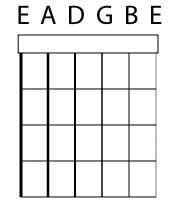Standard tuning is when the guitar is tuned to E, a, d, g, b, e. In the music industry it is the assumed default if a specific tuning is not mentioned.
Standard tuning provides simple fingering for many chords and the ability to play common scales with reasonable left-hand movement. The separation of the first (e’) and second (b) string, as well as the separation between the third (g), fourth (d), fifth (A), and sixth (E) strings by a five-semitone interval (a perfect fourth) allows notes of the chromatic scale to be played with each of the four fingers of the left hand controlling one of the first four frets (index finger on fret 1, little finger on fret 4, etc.) only when the hand is in the first position; otherwise, the four fingers must stretch to cover five frets.
The separation of the second (b), and third (g) string is by a four-semitone interval (a major third). The irregular major-third provides B and E as open notes, which is convenient for many chords. On the other hand, the irregular major-third breaks the fingering patterns of scales and chords, so that guitarists have to memorize three-to-four chord-shapes for each chord. Scales and chords are simplified by major thirds tuning and all-fourths tuning, which are regular tunings maintaining the same musical interval between consecutive open-string notes.
